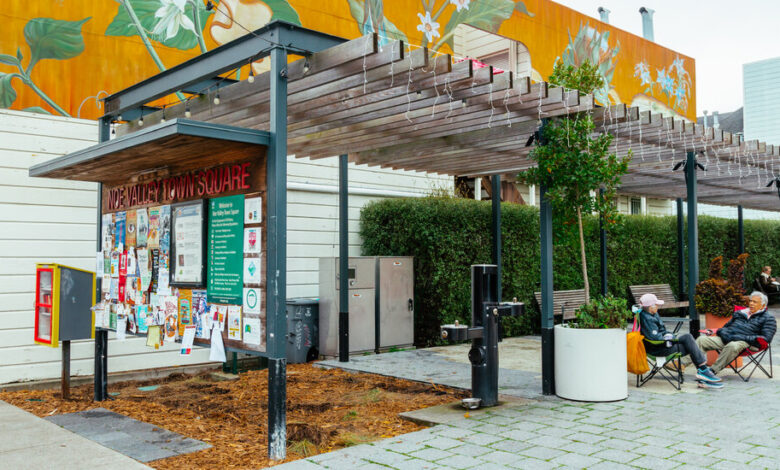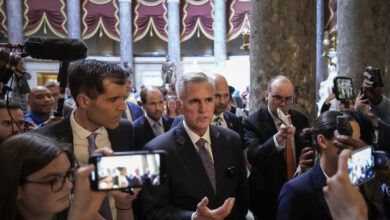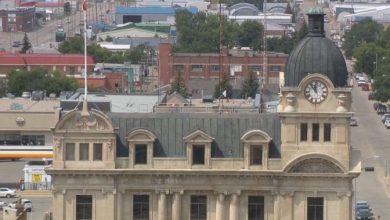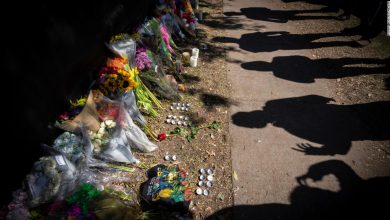San Francisco Tried to Build a $1.7 Million Toilet. It’s Still Not Done.

You could say San Francisco’s charming Noe Valley neighborhood has it all.
A thriving commercial corridor brimming with restaurants, bookstores and artisan coffee shops. So many throngs of young families that it has the moniker “Stroller Valley.” A town square with yoga classes and a farmer’s market.
But what Noe Valley still needs is a toilet.
Fifteen months after city officials were ready to throw a party in the Noe Valley Town Square to celebrate funding for a tiny bathroom with a toilet and sink, nothing but mulch remains in its place.
The toilet project broke down the minute taxpayers realized the city was planning an event to celebrate $1.7 million in state funds that local politicians had secured for the lone 150-square-foot structure. That’s enough to purchase a single-family home in San Francisco — with multiple bathrooms.
Even more confounding was the explanation that the tiny bathroom would take two to three years to install because of the city’s labyrinthine permitting and building process. City leaders quickly canceled their potty party, and Gov. Gavin Newsom of California took back the funds.
Late-night comedians skewered the city. Residents dubbed the saga “Toiletgate,” and the $1.7 million toilet soon became the “it” costume at local Halloween parties that year.
For many residents, the episode has illustrated why San Francisco so often gets bogged down by inefficiency. If an army of more than 30,000 city employees with a $14 billion annual budget cannot build a simple bathroom in a reasonable way, what hope is there that San Francisco can solve its housing shortage and fentanyl crisis?
“Why isn’t there a toilet here? I just don’t get it. Nobody does,” Ted Weinstein, a literary agent who lives in Noe Valley and passes by the Town Square daily, said on a recent weekday. “It’s yet another example of the city that can’t.”
Noe Valley neighbors had been pleading for a public toilet in the town square since it was converted from a parking lot in 2016. The makeover included plumbing for a bathroom, but no actual bathroom because money ran out. Children enjoying the playground and adults chatting over coffee at bright red tables have simply had to hold it.
City officials have tried to explain why $1.7 million was the normal price tag for a small public bathroom: the high cost of everything in San Francisco, including construction materials. Hiring an architect who would draw up plans. Soliciting community feedback on the design.
Numerous layers of review by commission after commission require the city to pay for staff time. Even the Civic Design Review Committee must determine whether a bathroom is “appropriate to its context in the urban environment.”
The difficulty of building a bathroom in San Francisco has shed light on why many projects face cost overruns and delays. A recent state report found it takes longer and costs more to build housing in San Francisco than anywhere else in California. It takes 523 days, on average, for a developer to get the initial go-ahead to construct housing — and another 605 days to get building permits.
And after spending five years and more than $500,000 to design bespoke trash cans — with the prototypes costing more than $12,000 apiece — the city has shelved a plan to put 3,000 of them on street corners because of a budget deficit.
Mayor London Breed has repeatedly vowed to slash the city’s red tape and has made it faster and easier for small business owners to get permission to open, and has backed local and state laws to speed housing construction. Her spokesman, Jeff Cretan, pointed to a quick overhaul last year of the decrepit United Nations Plaza into a skate park and a project planned nearby to turn office space into housing.
Still, he acknowledged, public projects take a lot of time and money.
“It’s worth changing the laws that are in place around construction projects like the restroom that slow things down,” he said.
In the case of the Noe Valley toilet, the bad publicity was enough to attract donors seeking good publicity. In November 2022, a month after the kerfuffle began, two businessmen in the toilet industry agreed to donate a modular bathroom and pay the installation costs, cutting the price tag by hundreds of thousands of dollars.
Chad Kaufman, president of the Public Restroom Company, offered to donate a modular toilet to the town square. His friend Vaughn Buckley, the chief executive of Volumetric Building Companies, vowed to provide free architecture and engineering work to get the site ready. The pair also said they would pay local union workers to install the commode.
The project seemed to gain steam once the city and Mr. Buckley’s company finalized an agreement in April 2023. But months have gone by with only weeds and mulch sitting where the toilet was supposed to go.
Discussions appeared to break down last year, according to a Dec. 22 letter from the city’s Recreation and Parks Department to Mr. Buckley.
“Your team was unresponsive to our repeated attempts to engage,” the letter declares. “We are receiving inquiries from citizens, journalists and local lawmakers on the status of this highly publicized project. We will need to answer questions.”
One of the sticking points, the letter states, was Mr. Buckley’s concern over high costs to hire local workers to complete his portion of the work. Mr. Buckley said this week that the city’s construction costs “continue to be a challenge” and contended that the city’s permitting process contributed to the delay. The toilet has now cleared those hurdles, and he said he hopes physical work can begin next month.
But Mr. Buckley said the bathroom should be ready for use by April — for less money and sooner than under the original time frame. Mr. Kaufman, the one donating the actual toilet, is still fully on board, too.
“My portion is done,” he said, noting the toilet is ready and waiting in the yard of his bathroom factory in Minden, Nev. He said he will pay for traffic control when a truck carrying the shrink-wrapped toilet eventually makes its way down 24th Street, and for a crane that will lift the loo into place.
Rafael Mandelman, a San Francisco supervisor who represents Noe Valley, said he has been trying to chip away at the city’s web of regulations that make projects so costly and time consuming. He is crafting a charter amendment to slim the city’s government structure, which includes 56 commissions and 74 oversight bodies.
Under city law, for example, installing the Noe Valley toilet — even the free one — requires that the Recreation and Parks Department coordinate with or seek approval from San Francisco Public Works, the Planning Department, the Department of Building Inspection, the Arts Commission, the Public Utilities Commission, the Mayor’s Office on Disability, and Pacific Gas and Electric.
“To unravel everything that needs to be unraveled to make government work, a lot of people have to focus on that as a very high priority,” said Mr. Mandelman. “It’s easy to push that aside as you run from crisis to crisis.”
In the meantime, Governor Newsom has released the $1.7 million back to San Francisco after city officials promised to use the funds to install two or three public toilets, not just one.
Little progress has been made on those, either.




